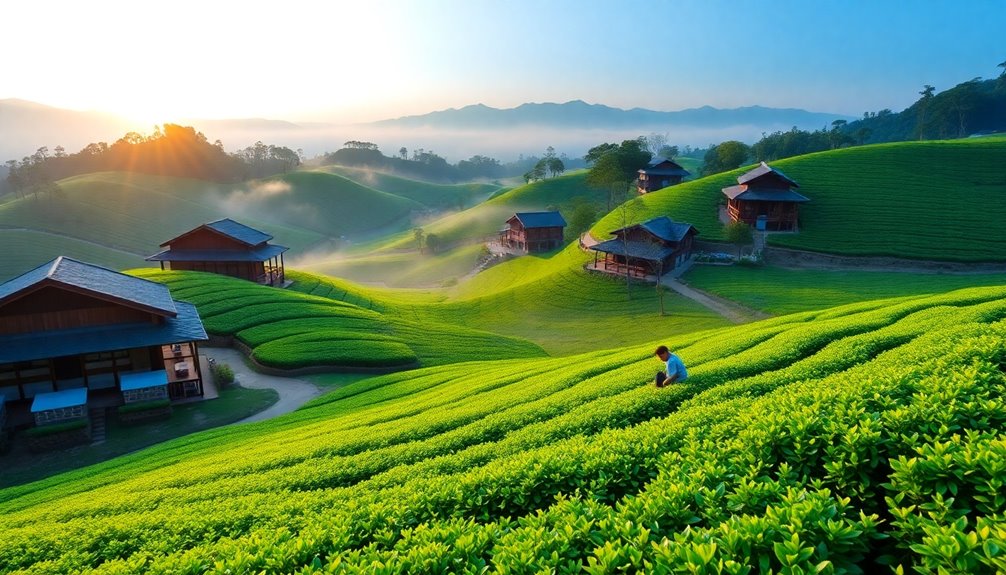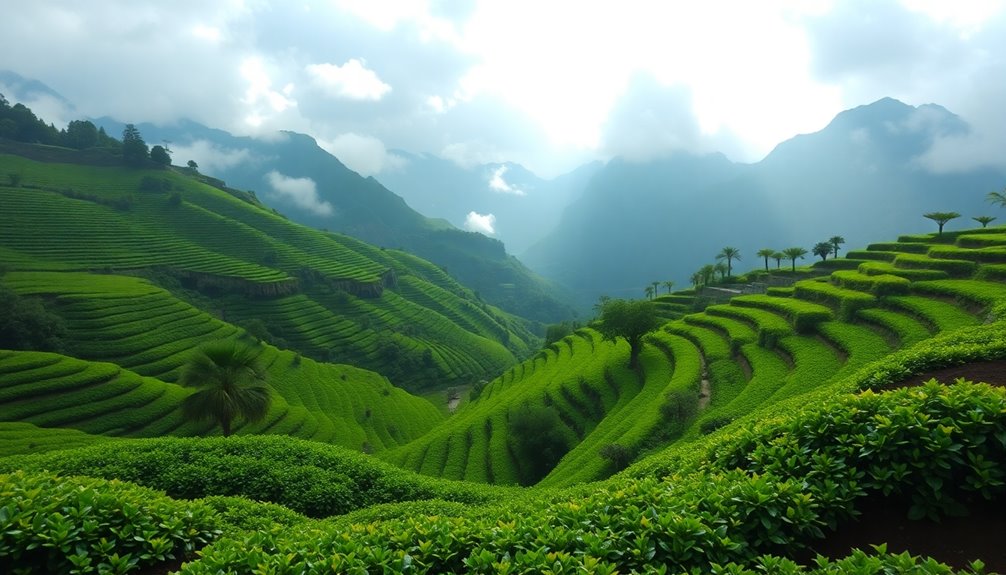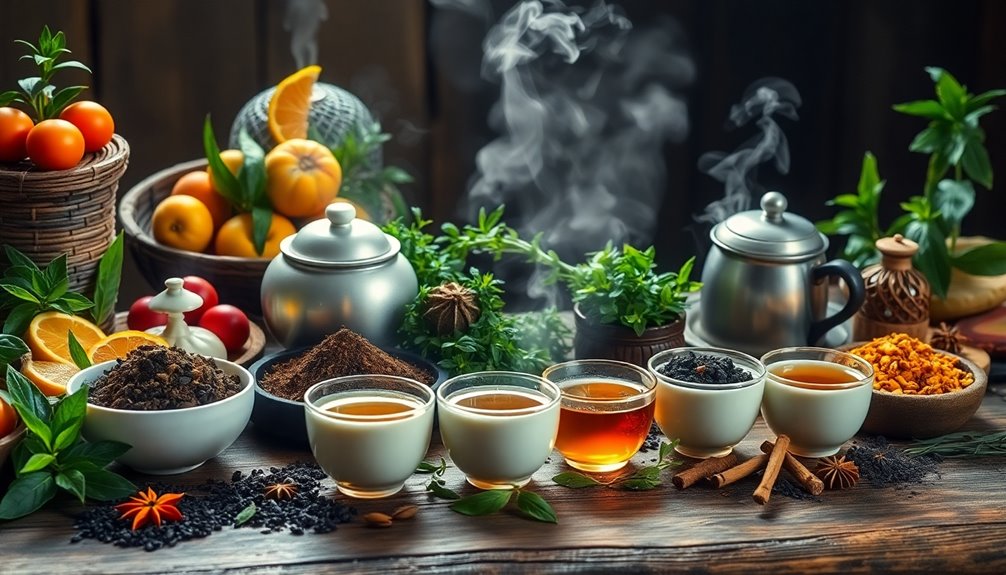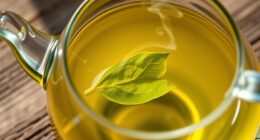Tea cultivation in Taiwan has a fascinating history full of flavor and tradition! It began in the late 1700s when tea was brought from Fujian Province. By 1717, wild tea was discovered in central Taiwan, sparking excitement. Soon enough, Taiwanese oolong tea became famous around the world! The Japanese colonial period (1895-1945) improved farming techniques, making tea even better. Today, Taiwan is known for its top-quality oolong tea and eco-friendly practices. Plus, tea's a big deal in Taiwanese culture, symbolizing warmth and friendship. Curious about more fun facts? There's a lot more to explore about this delightful drink!
Key Takeaways
- Tea was introduced to Taiwan from Fujian Province in the late 18th century, marking the beginning of local cultivation.
- The discovery of wild tea in central Taiwan in 1717 spurred interest in tea cultivation.
- By the mid-19th century, Taiwanese oolong tea gained global acclaim for its quality.
- The Japanese colonial period (1895-1945) modernized and improved tea cultivation processes in Taiwan.
- Indigenous cultivation practices and varieties have existed since the 17th century, enriching Taiwan's tea culture.
Introduction
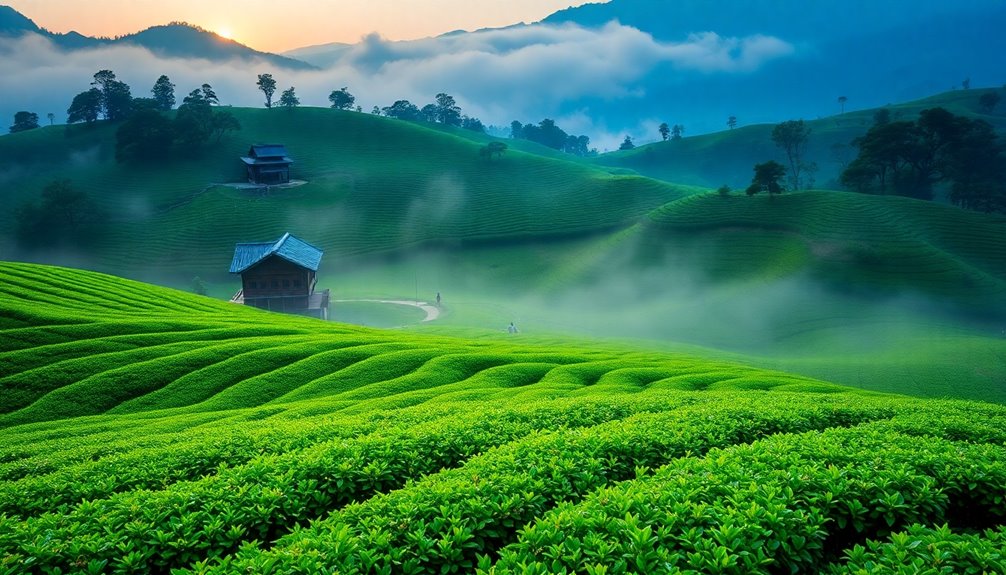
Tea cultivation in Taiwan has a rich history that dates back over 200 years. It all began in the late 18th century when tea trees were introduced from Fujian Province. This marked the start of a wonderful tea culture in Taiwan.
In 1717, folks discovered wild tea in central Taiwan, which got everyone excited about its potential. By the mid-19th century, Taiwanese oolong tea was gaining popularity worldwide, thanks to John Dodd, who helped promote its export in 1860.
During the Japanese colonial period from 1895 to 1945, tea cultivation really took off. They modernized the processes and built a strong infrastructure for tea production.
Today, Taiwan is famous for its high-quality oolong tea. You'll find various cultivars that are grown using sustainable farming practices, making Taiwan a star in the global tea market.
Here are some key points about tea cultivation in Taiwan:
- Introduced from Fujian Province
- Gained international recognition in the 19th century
- Modernized during the Japanese colonial period
- Known for sustainable farming and high-quality oolong tea
Isn't that exciting?
Tea's Role in Taiwanese Culture

In Taiwanese culture, the warmth of hospitality often unfolds around a cup of tea, embodying a rich tradition that goes beyond mere refreshment. You might hear the saying, "You have friends, and you have tea – so you're rich!" This highlights how tea connects people through social interactions and community gatherings.
Traditional tea ceremonies in Taiwan celebrate the quality and nuances of Taiwanese tea, showcasing the cultural heritage that makes tea drinking special. You'll find tea shops buzzing with chatter, where friends come together to enjoy unique local varieties. These lovely spaces foster connections and cultural exchange, making every sip a shared experience.
Annual festivals are a delightful part of tea culture, where you can taste different teas and learn about their unique processing methods. These events reinforce the importance of tea in Taiwanese identity, bringing communities together in celebration.
With 80% of Taiwanese tea enjoyed at home, it's clear that tea isn't just a drink; it's a cherished part of life! So, whether you're at a festival or a tea shop, embrace the joy and connection that a simple cup of tea can bring.
Tea's Economic Impact on Taiwan
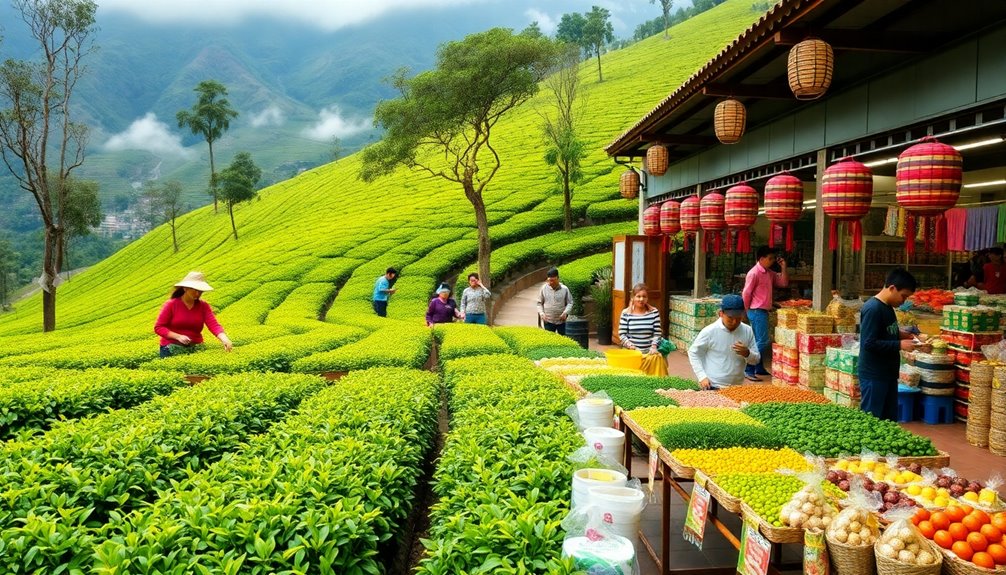
While many people enjoy tea for its cultural significance, it also plays a vital role in Taiwan's economy. The Taiwanese tea industry is a powerhouse, contributing about $50 million annually to the agricultural economy! Oolong tea, Taiwan's pride, leads the way in exports, especially to markets in the U.S. and Japan, showcasing its international fame.
Did you know that around 80% of Taiwanese tea is enjoyed right at home? This highlights how deeply tea is woven into everyday life and family gatherings.
To stay competitive, the tea industry has adapted since the 1950s, focusing on specialty teas and maintaining high quality. This ensures that each cup of tea you sip is top-notch!
The government also lends a helping hand to tea farmers through subsidies and marketing support. This teamwork not only boosts local consumption but also strengthens the tea industry's economic impact.
Indigenous Tea Cultivation Practices
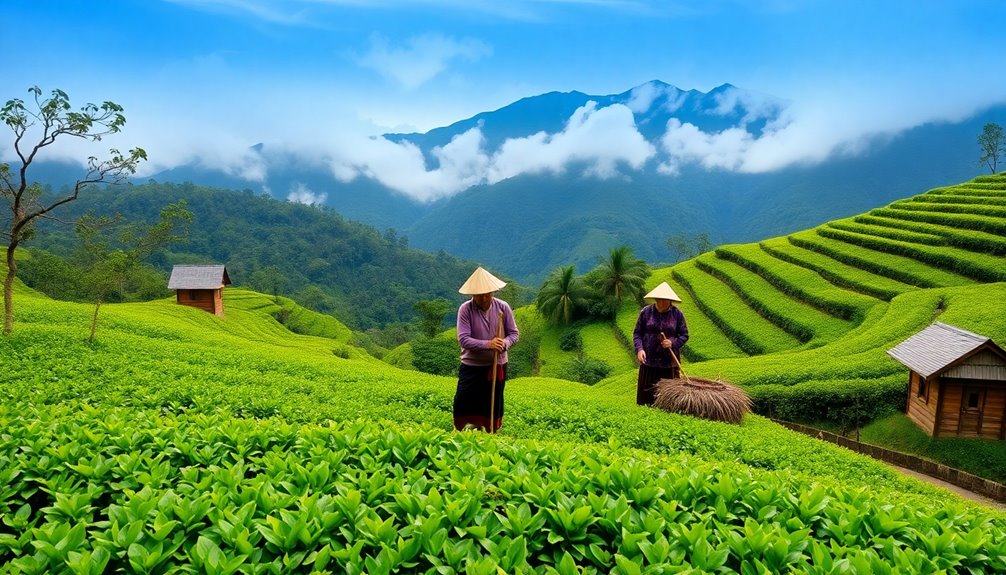
Taiwan's rich tea culture is deeply rooted in its indigenous practices, which have shaped the landscape of tea cultivation for centuries.
You'll find that indigenous tea varieties like Taiwan Mountain Tea and Red Sprout Mountain Tea, discovered in the 17th century, are truly special. While these teas initially had a bitter taste and thin leaves, making them less popular, their unique flavors are now celebrated.
Over 200 years ago, tea trees from Fujian Province were introduced, leading to a structured approach to tea cultivation in Taiwan. During the Qing dynasty, various tea varieties were brought to northern Taiwan, enriching the local tea culture.
One of the most charming aspects of indigenous tea cultivation is the hand-picking method. This practice emphasizes quality, allowing tea leaves to be selected with care.
It's not just about growing tea; it's about honoring the deep cultural significance it holds for communities.
Land Use Conflicts
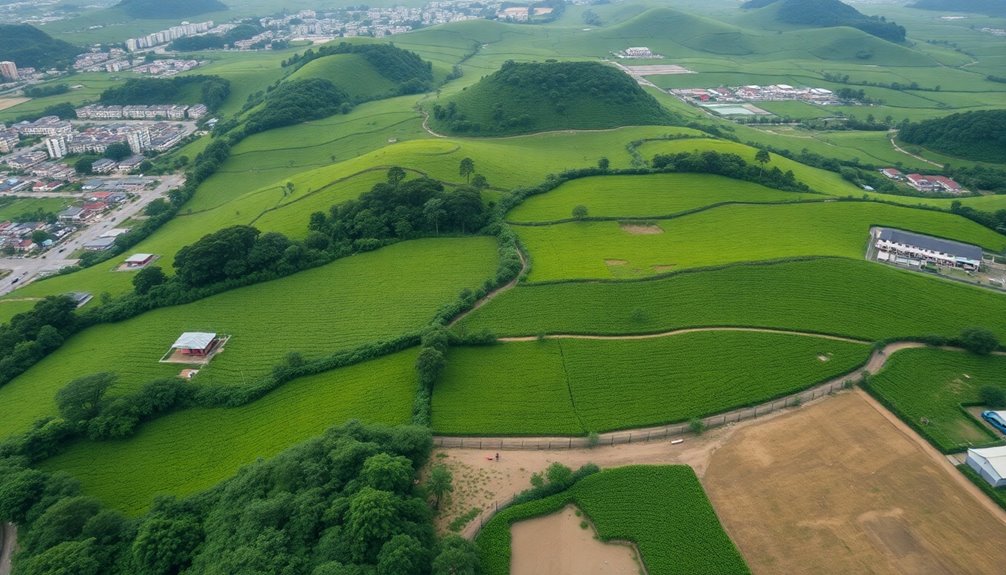
Conflict over land use has become a pressing issue in Taiwan, as tea cultivation battles against the relentless tide of urban development. You mightn't realize it, but tea farmers are facing tough choices as their agricultural land shrinks.
With the growth of new homes and infrastructure, traditional tea-growing areas, especially in Northern and Central Taiwan, are slowly disappearing.
Here are some key points about this situation:
- Urban Development: Residential projects take over land where tea was once grown.
- Pressure on Farmers: Many tea farmers feel pushed to sell their land for high-priced real estate.
- Agricultural Policies: These policies aim to balance urban growth with the need to keep farming alive.
- Sustainable Farming Practices: Farmers are encouraged to use methods that protect the environment while boosting productivity.
- Land Zoning: Ongoing discussions about land zoning impact tea cultivation and its future.
It's a tough battle, but tea farmers are passionate about preserving their culture.
Practical Applications
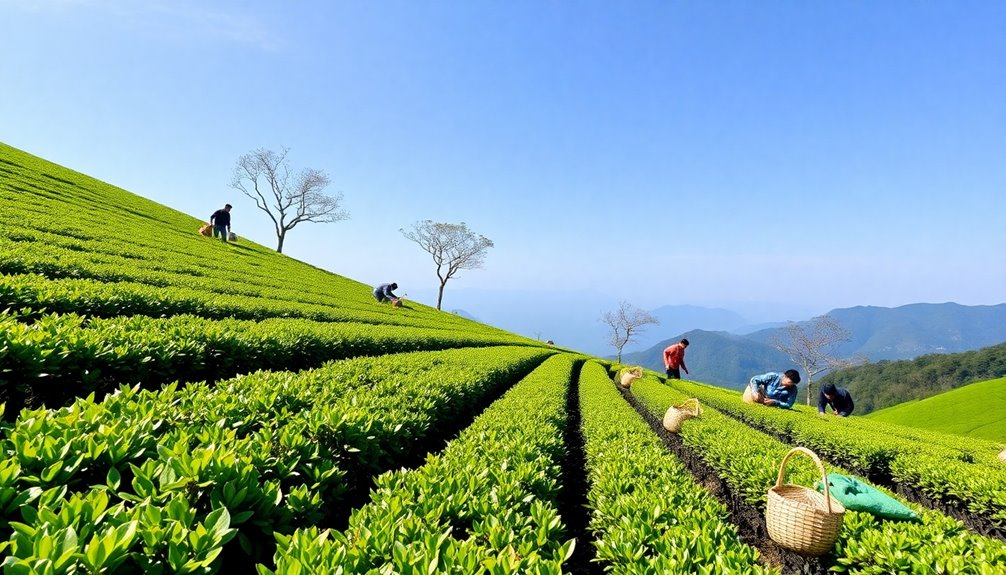
Tea cultivation in Taiwan offers practical applications that extend beyond just producing a beloved beverage. On the beautiful Taiwanese tea farms, you can find a variety of tea cultivars, with Oolong teas shining brightly. These farms thrive in the mountain terrain, where the cool climate helps create the best flavors.
Thanks to the Tea Research Institute, farmers use innovative agricultural methods to improve quality, especially for black tea production. This focus on quality has helped boost international demand for Taiwanese tea, with exports growing dramatically in the late 19th century.
With around 20,000 hectares of tea farms producing about 20,000 tons of tea each year, there's plenty for tea lovers to enjoy!
Plus, many farmers are embracing sustainable farming practices. This means they're not just growing tea; they're also caring for the environment, ensuring a healthier planet for future generations.
Frequently Asked Questions
What Is the History of Tea Farming?
You'll find that tea farming has evolved significantly over centuries, adapting to regional climates and market demands. Innovations in cultivation and processing have shaped its growth, resulting in diverse varieties and sustainable practices that thrive today.
What Is the History of Formosa Tea?
Formosa tea, especially oolong, gained fame in the late 19th century. John Dodd recognized its potential, leading to massive exports. By then, it became synonymous with Taiwan's identity and renowned for its exceptional quality.
What Is the History of Chinese Tea Culture?
Chinese tea culture's rich history spans over 5,000 years, evolving from medicinal use to social rituals. You'll discover unique preparation methods and regional varieties, each reflecting the artistry and traditions of its time.
What Is the Oldest Tea Growing Country?
You'll find that the oldest tea-growing country is China. With a rich history spanning over 2,000 years, it's shaped tea culture globally, influencing numerous countries' cultivation practices and creating diverse varieties enjoyed today.
Conclusion
In conclusion, tea isn't just a drink in Taiwan; it's a joyful part of life! Whether you're enjoying a cozy cup at home or celebrating with friends during a tea festival, you're part of a rich history. From its cultural roots to its tasty flavors, tea brings everyone together. So next time you sip your tea, think about all the hard work and love that goes into it. Cheers to the wonderful world of Taiwanese tea!

